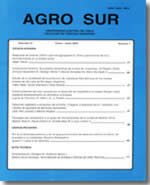Utilization of the Sun Spray Ultra Fine mineral oil with myclobutanil to control the Powdery Mildew of Grapes (Oidium tuckeri)
Main Article Content
Abstract
In order to have new alternatives to control Powdery Mildew of Grapes (Oidium tuckeri), the effect of the mineral oil Ultra Fine Sun Spray (UFSS) was evaluated in combination with the ergosterol biosynthesis inhibitor fungicide (IBE) myclobutanil.
The research was conducted in a Carignan vineyard located at the Rinconada de Maipú Experimental Station of the University of Chile, Metropolitan Region of Chile in the season 1996-97.
The treatments were as follow: Control (T0); mineral oil UFSS 1% in mixture with myclobutanil 2E (2.4 cc a.i./HL, minor commercial dosage) every 14 (T1), 21 (T2) and 28 days (T3); myclobutanil 2E (2.88 cc a.i./HL, maximum commercial dosage) every 14 (T4), 21 (T5) and 28 days (T6) and two commercial treatments T7 and T8, the first one consisted in applying sulphur WP (320 g a.i..HL) every 14 days and myclobutanil 2E (2.88 cc a.i./HL) at the end of blossom and the second included myclobutanil 2E (2.88 cc a.i./HL) applied at the beginning of the season and one at the end of blossom and sulphur WP (320 g a.i./HL) every 14 days.
The degree of control was measured by determining the incidence (% of clusters affected per plant) and severity (% of berries affected per clusters).
A 100% of infection of Powdery Mildew was developed in the control (T0). The results allow to conclude that myclobutanil sprays at a dosage of 2.4 cc i.a./HL + mineral oil SSUF 1% every 14 days are more effective than when this fungicide is used at a dosage of 2.88 cc i.a./HL applied every 14, 21 and 28 days. Also, the sprays of the mixture of myclobutanil (2.88 cc i.a./HL) with mineral oil UFSS 1% applied every 28 days was as effective as the application of myclobutanil alone every 14 days.
The less effective treatments were the commercials (T7 and T8) where were not observed differences between them when applying sulphur or myclobutanil at the beginning of the control program.
Berries harvested from plants treated with UFSS showed no decrease in sugar contents (ºBrix).
Also, an experiment to determine the myclobutanil persistence was made with the purpose of having a reference that supports the field results where myclobutanil was more effective to control the disease when was applied with mineral oil UFSS than the treatment with myclobutanil alone. The residual level of myclobutanil was evaluated in the berries at 0, 7, 14, 21 and 28 days, after applying myclobutanil alone (2.4 cc a.i./HL) and mixture with mineral oil UFSS 1%.
When mixed with myclobutanil, UFSS oil increases the persistence of this IBE fungicide achieving also a very good control of the disease with only 4 sprays during the season, compared with the 7 or more sprays needed when using only sulphur or IBE fungicides.

